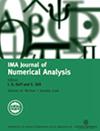随机Khatri-Rao积子空间嵌入及其在特征解中的应用
IF 2.4
2区 数学
Q1 MATHEMATICS, APPLIED
引用次数: 0
摘要
已经开发了各种迭代特征值求解方法来计算大型稀疏矩阵的部分频谱,包括幂方法,Krylov子空间方法,轮廓积分方法和预条件求解方法,如所谓的局部最优块预条件共轭梯度(LOBPCG)方法。所有这些求解器都依赖于随机矩阵来确定,例如,起始向量与感兴趣的特征向量有高概率的不可忽略的重叠。出于这个目的,一个安全且常见的选择是非结构化高斯随机矩阵。在这项工作中,我们研究了随机Khatri-Rao积在特征值解算中的使用。一方面,我们建立了一种新的子空间嵌入性质,为这种结构化随机矩阵的使用提供了理论依据。另一方面,我们强调了在解决Kronecker积结构的特征值问题时的潜在算法优势,因为它们经常出现在张量积域上微分算子的特征值问题的离散化中。特别地,我们考虑在轮廓积分方法和LOBPCG中使用随机Khatri-Rao积。数值实验表明,轮廓积分法的增益很大程度上依赖于有效、准确地求解右手边低秩的移位矩阵方程的能力。LOBPCG直接使用预调节器的灵活性使其更容易受益于Khatri-Rao产品结构,其代价是较少的理论依据。本文章由计算机程序翻译,如有差异,请以英文原文为准。
Subspace embedding with random Khatri–Rao products and its application to eigensolvers
Various iterative eigenvalue solvers have been developed to compute parts of the spectrum for a large sparse matrix, including the power method, Krylov subspace methods, contour integral methods and preconditioned solvers such as the so-called locally optimally block preconditioned conjugate gradient (LOBPCG) method. All of these solvers rely on random matrices to determine, e.g., starting vectors that have, with high probability, a non-negligible overlap with the eigenvectors of interest. For this purpose, a safe and common choice are unstructured Gaussian random matrices. In this work, we investigate the use of random Khatri–Rao products in eigenvalue solvers. On the one hand, we establish a novel subspace embedding property that provides theoretical justification for the use of such structured random matrices. On the other hand, we highlight the potential algorithmic benefits when solving eigenvalue problems with Kronecker product structure, as they arise frequently from the discretization of eigenvalue problems for differential operators on tensor product domains. In particular, we consider the use of random Khatri–Rao products within a contour integral method and LOBPCG. Numerical experiments indicate that the gains for the contour integral method strongly depend on the ability to efficiently and accurately solve (shifted) matrix equations with low-rank right-hand side. The flexibility of LOBPCG to directly employ preconditioners makes it easier to benefit from Khatri–Rao product structure, at the expense of having less theoretical justification.
求助全文
通过发布文献求助,成功后即可免费获取论文全文。
去求助
来源期刊
CiteScore
5.30
自引率
4.80%
发文量
79
审稿时长
6-12 weeks
期刊介绍:
The IMA Journal of Numerical Analysis (IMAJNA) publishes original contributions to all fields of numerical analysis; articles will be accepted which treat the theory, development or use of practical algorithms and interactions between these aspects. Occasional survey articles are also published.

 求助内容:
求助内容: 应助结果提醒方式:
应助结果提醒方式:


